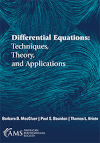- About MAA
- Membership
- MAA Publications
- Periodicals
- Blogs
- MAA Book Series
- MAA Press (an imprint of the AMS)
- MAA Notes
- MAA Reviews
- Mathematical Communication
- Information for Libraries
- Author Resources
- Advertise with MAA
- Meetings
- Competitions
- Programs
- Communities
- MAA Sections
- SIGMAA
- MAA Connect
- Students
- MAA Awards
- Awards Booklets
- Writing Awards
- Teaching Awards
- Service Awards
- Research Awards
- Lecture Awards
- Putnam Competition Individual and Team Winners
- D. E. Shaw Group AMC 8 Awards & Certificates
- Maryam Mirzakhani AMC 10 A Awards & Certificates
- Two Sigma AMC 10 B Awards & Certificates
- Jane Street AMC 12 A Awards & Certificates
- Akamai AMC 12 B Awards & Certificates
- High School Teachers
- News
You are here
Differential Equations: Techniques, Theory, and Applications

Buy Now:
Publisher:
AMS
Publication Date:
2020
Number of Pages:
874
Format:
Paperback
Price:
125.00
ISBN:
978-1-4704-4797-7
Category:
Textbook
[Reviewed by , on ]
Eric Strachura
07/5/2021
This book can serve as a textbook for various types of introductory differential equations courses. As the title suggests, there is a balance between theory, techniques and applications (of which there are many in this book!). A large number of problems and applications are in the life sciences in addition to the physical sciences.
The tone is more conversational than might be expected for a differential equations textbook. As the authors themselves state, the book is meant to be read! Although quite lengthy, the book is readable and strikes an interesting balance between informal and formal. Students are not overly burdened with formal proofs, but some proofs are there. More often than not, various explanations of the theorems are given in an informal
environment.
The book could certainly serve as a textbook for an engineering-focused differential equations course and could span either a semester or a year long course (there is certainly enough material for a one-year course–including a chapter on Partial Differential Equations at the end). The prerequisites include a year long course in single variable calculus. With any other material, such as partial derivatives, plenty of background is given. Moreover, there are many references also provided at the end of the book for those who wish to go into more detail on a given subject.
The exercises at the end of each section are interesting and not merely just direct applications of the theory. Some of the problems are related to current events (relatively speaking), such as a number of problems on separable equations related to Usain Bolt’s 100-meter final in the 2008 Olympics, where the authors have included Bolt’s actual 100 meter split times. The authors suggest that some of these problems could be used for in-depth projects (individually or in groups), which seems quite reasonable. Many of the exercises are also available through WebAssign.
The authors convey to the students that differential equations appear in everyday life, and they strengthen this assertion with the real world exercises as mentioned above. Overall, even though this book is long, it should not be seen as intimidating, as many details and pictures are provided in a reader friendly setting.
Eric Stachura is currently an Assistant Professor of Mathematics at Kennesaw State University. He is generally interested in analysis and partial differential equations.
See the publisher's website.
- Log in to post comments




